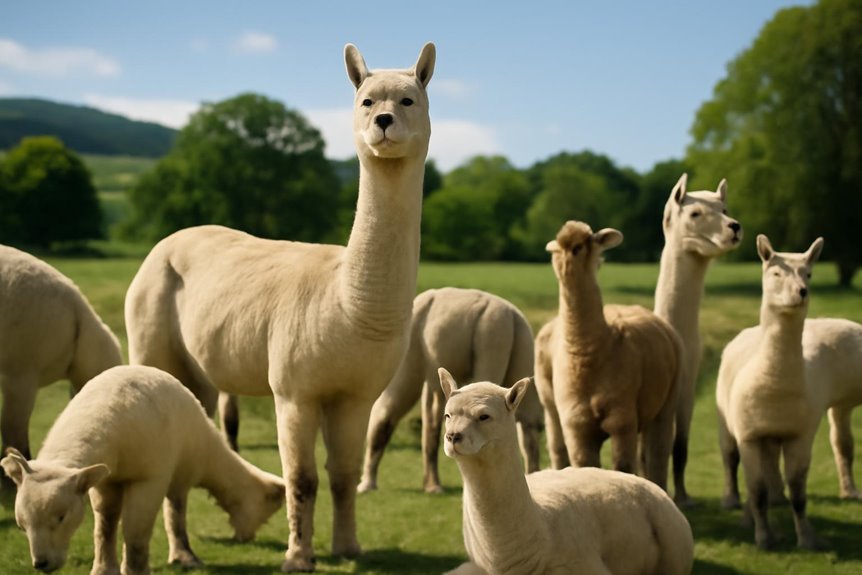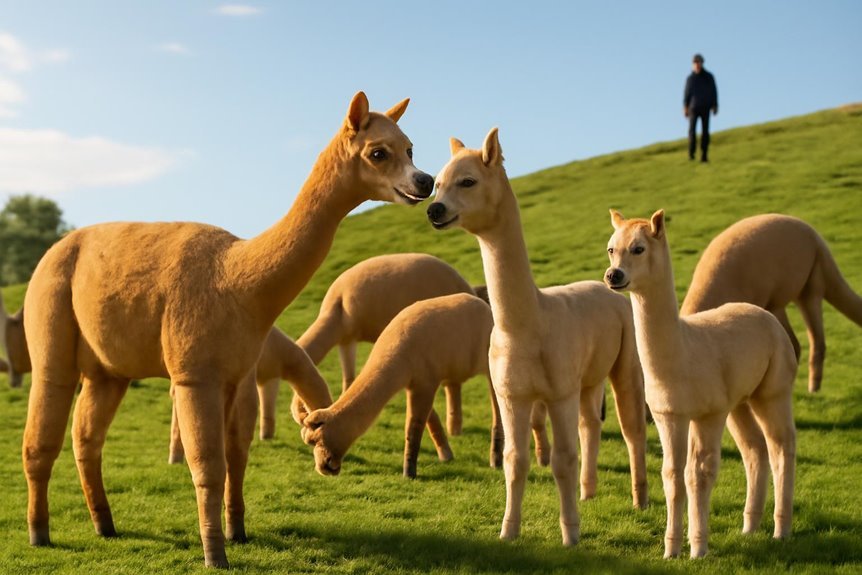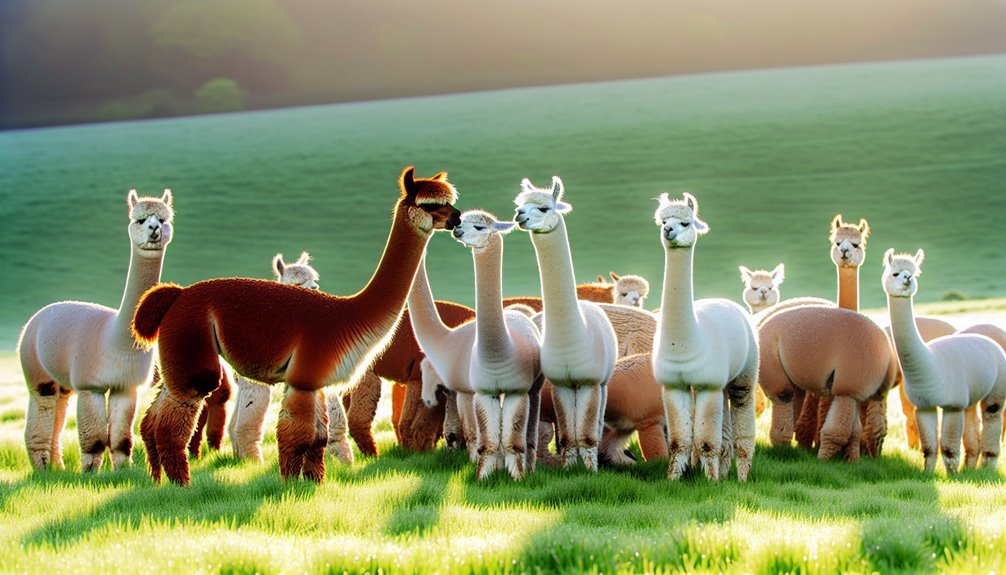5 Tips for Observing Alpaca Herd Dynamics
To observe alpaca herd dynamics, start by recognizing each animal’s social role like leader or babysitter, which influences group behavior. Pay close attention to body language and vocalizations such as humming or snorting to understand their emotions. Monitor any changes in grouping or posture that might signal stress or illness. Remember, your gentle and consistent interaction impacts their comfort and trust. Keep watching closely, and you’ll soon uncover deeper insights into their complex social world.
Key Takeaways
- Observe body language and vocalizations like humming, snorting, and clucking to understand alpaca emotions and social cues.
- Identify each alpaca’s social role (leader, follower, guard, babysitter) to gauge herd structure and relationships.
- Monitor changes in grouping and behavior for signs of stress, illness, or social tension within the herd.
- Watch for signs of stress such as pacing, isolation, or increased aggression indicating disruptions in herd dynamics.
- Interact consistently and gently with alpacas to build trust and positively influence herd social behavior.
Recognizing Social Roles Within the Herd

Although alpacas may seem calm and uniform, they actually have a clear social hierarchy within their herd. Each alpaca holds a specific role—like leader, follower, guard, or babysitter—that shapes their interactions. The leader plays a crucial role in guiding the group, and their presence affects the comfort and behavior of others. When observing your alpaca herd, watch for attention shifts and interactions that hint at changing social standings. Segregation from the herd can cause stress and behavioral issues, as it disrupts established roles. Introducing new members or removing alpacas requires careful monitoring to manage social reorganization smoothly. Understanding these dynamics helps you support your herd’s well-being and maintain harmony within the group.
Interpreting Body Language and Vocalizations
Understanding the social roles within your alpaca herd is just one part of caring for them. To truly interact with alpacas, you need to interpret their body language and vocalizations. Alpaca behavior as herd animals relies heavily on subtle cues. When an alpaca hums, it’s expressing emotions from contentment to anxiety, so context matters. Snorting signals a warning that their personal space is threatened, while clucking often shows concern or friendliness toward humans or other alpacas. Pay attention to body posture—a lowered head or tense stance can indicate stress. Remember, individual alpacas may respond differently, and some even learn to link commands with actions. By reading these signals carefully, you’ll enhance communication and better support your herd’s well-being.
Monitoring Changes in Behavior and Grouping
When you keep a close eye on how your alpacas group themselves and behave, you can spot changes that hint at stress, illness, or social tension early on. Monitoring the herd helps you catch subtle shifts in behavior or grouping that new owners might miss. Watch for these signs:
Observing alpaca group behavior helps detect early signs of stress, illness, or social changes.
- An alpaca isolating itself from the main group, signaling possible illness or stress.
- Sudden changes in body posture or head position indicating discomfort.
- Disruptions in established social clusters, especially after introducing new alpacas.
- Increased agitation or avoidance behavior during interactions within the herd.
Understanding the Impact of Human Interaction

Since alpacas are highly perceptive of human behavior, your interactions with them play an essential role in shaping their responses and overall herd dynamics. When you engage in positive interaction with alpacas as pets, you help build trust and encourage socialization within the group. Alpacas remember past experiences, so consistent, gentle handling improves their comfort and willingness to cooperate. Paying attention to non-verbal cues like your body language and facial expressions also influences their reactions. By fostering a trusting environment through regular positive interaction, you can reduce fear and aggression, promoting smoother herd dynamics. Understanding this impact helps you create a harmonious setting where alpacas feel secure, ultimately enhancing their social bonds and making your role as a caregiver more rewarding.
Identifying Signs of Stress and Disruption
Although alpacas are generally calm animals, you’ll notice signs of stress or disruption if their social environment becomes unsettled. When observing a group of alpacas and llamas, it’s essential to monitor behaviors closely for early signs of stress. Here are key indicators to watch for:
- Pacing, excessive humming, or isolation from the herd, signaling emotional distress.
- Increased aggression or bullying, showing disruptions in herd dynamics.
- An alpaca consistently kushing alone while others graze, possibly indicating health issues.
- Sudden withdrawal from social interaction, often a sign of emotional or physical distress.
Recognizing these signs allows for careful management to restore harmony and guarantee the well-being of your herd.
Frequently Asked Questions
How to Tell if an Alpaca Is Happy?
You’ll spot happy alpaca behaviors through relaxed body language cues, gentle vocalizations signaling happiness, and signs of contentment like playful activities displayed. Observing social interactions and environmental factors influencing mood helps you know when they’re truly content.
How Do Alpacas Show Affection to Humans?
Imagine an alpaca softly humming and gently nudging you, seeking proximity with relaxed posture. You’ll notice playful behavior or licking affection—these alpaca body language signs show they trust and bond with you deeply.
What Not to Do Around Alpacas?
You shouldn’t chase alpacas or make loud noises that stress them. Avoid sudden movements, respect their personal space, keep a safe distance, don’t feed without permission, and always observe quietly to guarantee they stay calm and comfortable.
How Many Alpacas Are on 1 Acre?
You should aim for 2 to 4 alpacas per acre, balancing ideal density for alpaca grazing and social interactions. Proper land management, fencing requirements, and meeting nutritional needs guarantee your herd size stays healthy and stress-free.







Our picks
Alpaca & Wool Felted Sole Inserts: Comfy Upgrade?
Best Alpaca Socks for Hiking: Ultimate Comfort and Durability on Trails
Best Alpaca Halter for Comfort and Control